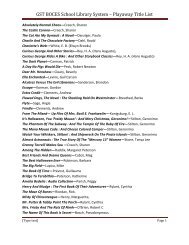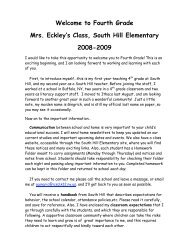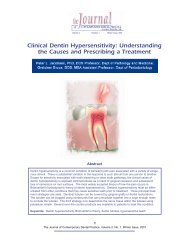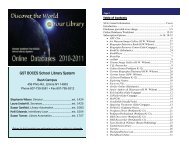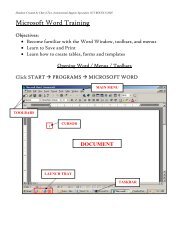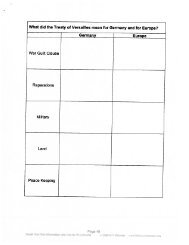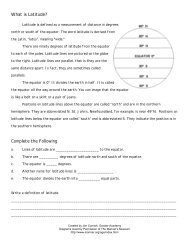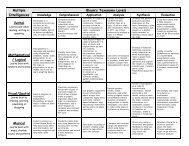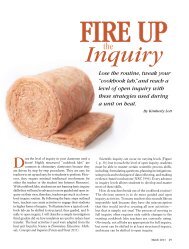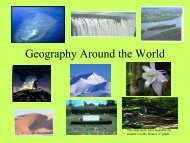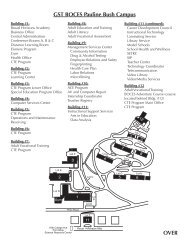Fostering Argumentation Skills - gst boces
Fostering Argumentation Skills - gst boces
Fostering Argumentation Skills - gst boces
You also want an ePaper? Increase the reach of your titles
YUMPU automatically turns print PDFs into web optimized ePapers that Google loves.
<strong>Fostering</strong><strong>Argumentation</strong> <strong>Skills</strong>Doing What Real Scientists Really Doby Douglas Llewellyn and Hema RajeshElementary and middle school teachers oftenprovide students with hands-on activitiesor even inquiry-based investigationsthat emphasize science process skills suchas observing, classifying, identifying and controllingvariables, hypothesizing, experimenting, and collectingand analyzing data. These activities and investigationsare frequently accompanied by the teachersaying, “Wow, now you’re acting like a scientist.”Unfortunately, this type of comment often reinforcesthe misconception that the “scientific method” is theHoly Grail with which experts investigate the naturalworld. Without a realistic perception of the work ofreal scientists, there may be little hope of achievingnational scientific literacy. The purpose of this articletherefore is threefold: (1) to illustrate how scientificargumentation paints a more accurate picture of thework that scientists really do and, more importantly,(2) to demonstrate how teachers can foster argumentbasedscience inquiries where students generate argumentsto support their claims using relative andsupportive evidence, and (3) to show how studentscan use scientific reasoning skills to analyze and communicatethe findings of their investigations.The case for argumentation is supported by theNational Research Council’s “Five Features of ScienceInquiry” (NRC 2000), in which the NRC states that withscience inquiry the learner• engages in scientifically oriented questions;• gives priority to evidence when responding toquestions;• formulates explanations from evidence;• connects explanations to scientific knowledge; and• communicates and justifies explanations.From these points, two keywords stand out thatreveal the true nature of science: evidence andexplanations. This article will further describe howteachers of science can foster scientific reasoning skillsat the conclusion of a lab by emphasizing scientificargumentation—a progression where students (1)investigate questions and assumptions from a puzzlingphenomenon or event, (2) use the data from a selfdesignedinvestigation to make a claim and justify anddefend the claim with supporting evidence, and (3)provide a scientific explanation based on the findings.22 SCIENCE SCOPE
FIGURE 1ExplanationsScientific-argumentation cycleObservationsScientific<strong>Argumentation</strong>QuestionsandAssumptionsThe illustration in Figure 1poses an interesting quandary—which comes first, the claim or theevidence? Similar to the chicken-orthe-eggdilemma, in the formationof the claim, data and evidenceare used to generate the claim.However, in the communication ofthe claim, the evidence supportsthe claim and is usually followed bythe statement of the claim.SupportingEvidenceWhat is the structure of ascientific argument?ClaimsThe progression of a scientific argument frequentlycommences with an observable event (see Figure1). This may be presented by the teacher in the formof a demonstration, a discrepant event, an initiatingexploration, or any perplexing phenomenon thatcauses students to raise questions that they canlater investigate. The process also involves studentsdeclaring what they already know about the event(their prior knowledge) and describing severalassumptions as to the causes or promising solutionsto the question or problem. In this case, theassumption is a statement that describes a naturalphenomenon or a framework to construct a possibleanswer to the question being studied. It can lead toa tentative answer or solution (hypothesis) to thequestion.Next, students design and carry out an investigationand then collect and analyze the data to look forpatterns and relationships among the variablesexamined. From the data and patterns, one or moreclaims are constructed. The claim is an assertionor conclusion that attempts to answer the originalquestion. The claim is then supported by evidence.The evidence is extracted from that data in the form ofobservations and measurements, which supports thelegitimacy of the claim and is justified and defendedvia oral presentations or written argument-based labreports. Finally, students structure explanations duringthe presentations or reports that account for the claimsand evidence.Data versus evidenceThe difference between data andevidence is sometimes confusing.Simply, data are the informationand measurements from aninvestigation. Evidence is a particular subset of dataan investigator uses to support or refute a claim.Because many students are already familiar with forensicscience by way of crime shows such as CSI,an example for students is the crime scene, which isusually loaded with data. In the legal system, the prosecutoror district attorney uses the data to make oneclaim based on selected evidence, while the defenselawyer extracts evidence from the same set of data tomake a contrary claim. It is then the jury’s responsibilityto decide which claim is best proven basedFIGURE 2Comparing data and evidenceDataEvidenceSeptember 2011 23
<strong>Fostering</strong> <strong>Argumentation</strong> <strong>Skills</strong>FIGURE 3upon the preponderance of the evidence. Hand et al.(2009) provide a clear relationship between data andevidence, showing that all the data collected duringan investigation may not be relevant to the questionbeing investigated (see Figure 2). See “Data VersusEvidence: Investigating the Difference” in this issuefor additional information on this topic.<strong>Argumentation</strong> in everyday lifeWhether we realize it or not, we areconstantly bombarded with claimsby today’s media. We hear claimsabout how to lose weight, how tostop smoking, the effects of globalwarming, the benefits of herbalmedicines, or how to make soundfinancial investments. During themonths leading up to an election,claims by political candidates arerepeated in infomercials and flyersthat fill mailboxes. Deciding whichcandidate is telling the truth withaccurate and relevant evidencecan be a daunting decision. Thus,understanding the connectionbetween claims and evidencebecomes a skill extending beyondthe science classroom.<strong>Fostering</strong> scientificreasoning skillsIf scientific inquiry asks, “Whatif…?,” then scientific reasoningasks, “Why…?” Scientificreasoning is the logic behindscientific inquiry. Becoming sci-Reasoning links claims to evidenceObservations Claims EvidenceFIGURE 4Day 1Day 2Day 3Day 4Day 5Days 6and 7Day 8Day 9entifically literate impliesbeing able touse scientific reasoningskills. In argumentation,students usescientific reasoningskills when explaininghow the claim and theevidence are connected.In their oral defenses,students linkthe claim to supportingevidence by using reasoning skills (see Figure 3).But, like inquiry, we should not expect that reasoningskills develop implicitly. Initially, students need to beexplicitly taught and nurtured through concrete experiencesof simple, observable discrepant events,where teachers use questions and prompts to elicit“evidence-based” explanations. Before engaging studentsin scientific argumentation, several pre-activitiespromoting scientific argumentation can be tappedReasoningDay-by-day planIntroduction and discussion of a soil profile.Discussion about the factors that promote soil fertility.Students walked around the school campus to observethe rich biodiversity there and identified rationales aboutwhat promoted growth. Safety procedures reviewed.In groups of four, students collected soil samples fromdifferent areas throughout the school.Using the school library and online resources, studentsresearched and discussed procedures to analyze the soilsamples.Students collected the required materials from the laboratoryand started to test their soil samples.Students completed the test and analysis. Students completedtheir QCEE sheets.Students prepared charts for their argument-basedpresentations.Using the QCEE sheets, groups presented their claimsand evidence while the rest of the class pointed outstrengths and limitations of the findings, often offeringalternative explanations and counterclaims.24 SCIENCE SCOPE
<strong>Fostering</strong> <strong>Argumentation</strong> <strong>Skills</strong>as students struggle with the task ofproposing, supporting, critiquing, FIGURE 5refining, justifying, and defending aposition. These activities center onstudents making observations andinferences. Later, through additionalpractice, they will become moreadept at linking claims to evidence.In one activity (Llewellyn2007), students are presentedwith six small, sealed juice or milkcontainers; each contains a commonobject such as a battery, a rubberball, a Styrofoam ball, severalmarbles, a domino or woodenblock, or a penny. Each of the sameobjects is placed in a clear, plasticbaggie so students can easily seeit. Students then shake each closedcontainer, make observations usingthe senses of hearing and touch,and infer which object in the container matches theobject in the bag. The container remains closed afterstudents have made all of their inferences. Studentsneed to rely on their observations to make justifiableinferences and conclusions.A second activity (Llewellyn 2007) involves a typicalblack box model. Here, students are presented with asealed shoe box containing two wooden blocks gluedto the bottom of the inside of the box and a marble.Like with the juice boxes, students make observationsto infer the location of the wooden blocks by slidingthe marble back and forth inside the box. By drawingan illustration, students can make a model as to thelocation of the two blocks—hereby making a claimbased on the evidence collected.Mystery Hands is a third activity that is simple todo. The teacher tapes a sheet of butcher paper acrossthe opening of an open door frame. Two holes, about15 cm (6 in.) in diameter, are made side by side nearthe center of the paper. A “mystery person,” in thehallway side of the door, places his or her handsthrough the openings. The mystery person can be anadult from the school or another student. Students onthe classroom side of the paper approach the hands,make observations about the hands and fingers, anddraw inferences about the person on the other side. Isthe mystery person a male or a female? How old is theperson? What kind of work does the person do?Similar activities, such as the familiar Track Stories,QCEE templateClaimQuestionExplanationEvidencecan be used to have students make observations andinferences (AGI 1984). These basic science processskills serve as rudimentary scaffolding for makingclaims and citing supporting evidence.Flaws in scientific reasoningIt is often said that middle school students are goodat school-yard arguing, but not at using the skills ofargumentation and scientific reasoning. Without explicitinstruction, students often make claims basedon their opinions and previously held, naive conceptions.Students’ lack of prior experiences and opportunitiesinitiates many of their claims and explanations.To help students develop skills in argumentation andreasoning, we need to provide sufficient “think time”for students to give their explanations. This meansallowing students to complete their thoughts and responseswithout interruptions from other students orthe teacher. In our fast-paced, time-constrained curriculum,this is a paramount challenge to rise above.Flaws in students’ reasoning can also be overcomeby teachers’ questions and prompts that promotescientific argumentation. Verbal prompts include thefollowing:• What assumptions can you make about theobservation?• What is the basis for your claim (or inference)?September 2011 25
<strong>Fostering</strong> <strong>Argumentation</strong> <strong>Skills</strong>• What evidence did you collectthat supports your claim, youridea, or your hypothesis?• Why do you think this is so?• What do you mean by…?• Does the evidence support orrefute your claim?• Are the data biased? Are the datareliable?• How would you interpret the dataand evidence?• What is the relationship betweenthe independent and dependentvariables?• What do the data say or imply?• What conclusions can you drawfrom the evidence?• How does the evidence supportor refute your claim?• How is one variable dependentupon another?• What explanation can you proposefrom the evidence collected?• How do the results support whatyou expected?• How do the results support whatyou already knew about thephenomenon?• Can you develop an explanationfrom the results?• Can you construct a model tosupport your explanation?• Were your original assumptionsabout the question correct?• How will you defend yourfindings?FIGURE 6Student QCEE template 1Question: Will this soil sample support good vegetation?ClaimThe area from where the soil wastaken was arid; it will not be able tosupport vegetation. The soil has toomuch sand and gravel.The humus layer in the soil is lowbecause it formed a smaller layerwhile the soil was sediment.The pH would be 7 or 8, as we donot use chemicals that would beeither acidic or alkaline on the soilor on plants at the school campus.We think the water retention of thesoil would be low, as the soil haslow humus content.The soil may have some nutrientspresent because the soil is notdisturbed.EvidenceGravel = 20%Humus = 7%Clay = 7%Coarse sand = 6%Fine sand = 60%Humus content = 7%pH = 8Explanation30% per 10 g of the soilThe soil has nitrates, sulfates, andiron.From the evidence, we can infer that the soil cannot support heavy vegetationas the humus content is very low. 60% of the soil is sand, whichmakes it difficult to support the growth of plants. The pH of the soil is 8,so it can support good vegetation. But the humus content is low, so thesoil is not fertile. The water-retention capacity is high. This may be due tothe presence of clay in the soil, or we might have taken wrong readings.Therefore, we can say that our soil has ideal pH, but other factors are notsuitable to support thick vegetation. Maybe over the course of time, humusmay enrich the soil due to the biological degadation by the microbes.One teacher’s storyIn this section, coauthor and science teacher HemaRajesh recounts her first experience in integratingargumentation into inquiry investigations at the TVSAcademy in Hosur, India. Here is Hema’s story:In grade 9 at the TVS Academy in Hosur, India, studentsstudy the factors that promote soil formation.Instead of having them do typical laboratory experimentsand write a report, I wanted a differentapproach that would make the class lively and enablestudents to justify their results through arguments—justlike real scientists do. I was motivatedwhen I read the article “Generate an Argument: AnInstructional Model” by Victor Sampson and JonathonGrooms in The Science Teacher (2010). After26 SCIENCE SCOPE
<strong>Fostering</strong> <strong>Argumentation</strong> <strong>Skills</strong>an introductory soil lesson, I askedstudents to observe the biodiversityin our school campus, whichis filled with over a hundred floweringplants. Students immediatelystated an assumption that becausethe soil supported a great numberof plants, it was rich in humus content.This assumption set the ballrolling. The big question studentscame up with was “What promotessoil fertility?” To explore this aspectof the soil, students decided toidentify the pH of the soil, humusdepth (along with other layers inthe soil), humus content in percentage,water-retention capacity,and qualitative estimation of mineralions (such as sulfates and nitrates)as variables that impact soilfertility. The timeline for the ninedaylesson is found in Figure 4.Students first divided themselvesinto seven groups comprising fourmembers per group. They thenchose various locations on theschool campus from where theytook soil samples for analyses. Safetynote: Safety glasses and glovesmust be worn when collecting soilsamples and testing soil. Collectionsites must be screened by theteacher for biological and chemicalcontaminants. The soils were takenfrom areas where the vegetationwas high, moderate, and low. Fromlearning about soil factors in theFIGURE 7lower grades, they initially assumed that the humuscontent varied. Students also came up with anotherassumption: that the pH of the soil would range from6 to 8 because the soil was free from chemical pollutionthat would alter the pH, and because they sawplants growing luxuriantly on the school campus. Inregard to safety measures, the proper handling ofacids was given prior to the procedure. In addition,while digging in the soil for samples, students weresupervised by the teacher and the school gardener.From the data, students were able to relate thatclay and humus content in the soil increased thewater-retention capacity of the soil. If the soil appearedStudent QCEE template 2Question: Is the soil fertility high or low?ClaimEvidenceThe area from where the soilwas taken was undisturbed withroyal palm trees. Since the soil isundisturbed, we think the humuslayer would be high in terms ofdepth of the soil.The percentage content of humusin the soil would be high.The pH of the soil must be neutralor slighty basic.The water-retaining ability of thesoil will be low.The soil may have some nutrients.Gravel = 44%Humus = 16%Sandy soil = 40%Humus content = 8%pH = 7Explanation4% per 10 g of the soilThe soil contains nitrates, sulfates,and iron.The soil shows only three well-marked zones. Clay is totally absent andthe depth of the humus layer is very small. The humus content is medium.The sample does not have clay, which would be helpful in retaining water.As the water is supplied externally, the plants are able to grow. But asthe soil is neutral, it is ideal for supporting good vegetation. To enhancefertility we can supply organic manures to the soil so that pH balance isnot disturbed. As the nutrients are present in the soil, organic manures willfurther increase the nutrient concentration in the soil.red to dark brown, it indicated the presence of ironin the soil. To help students summarize their dataas follow-up claims and evidence, I provided themwith a question-claim-evidence-explanation (QCEE)template (see Figure 5).When the groups analyzed the data and documentedtheir claims on QCEE templates (see Figures6 and 7), they were able to determine whether thefindings were concordant or not. For instance, Group3 had reported that the humus content was only0.14%, which was very low for the soil. After hearingcounterarguments from peers, students in the groupagreed that they had made a mistake, repeated theirSeptember 2011 27



